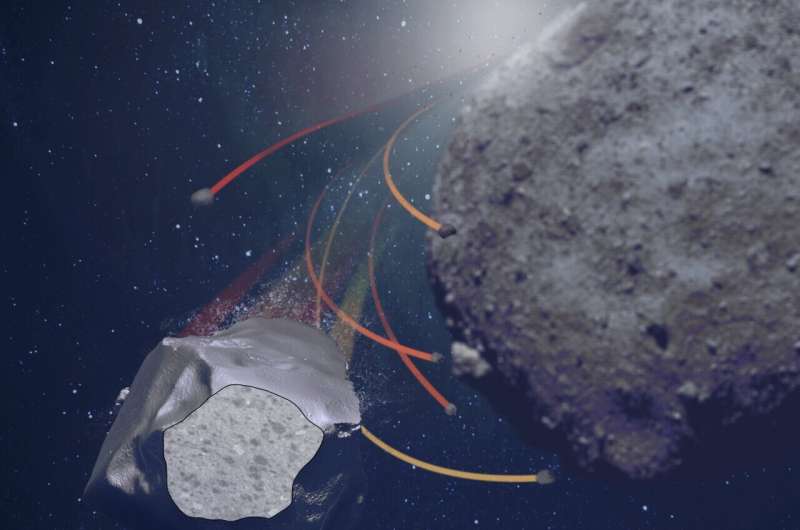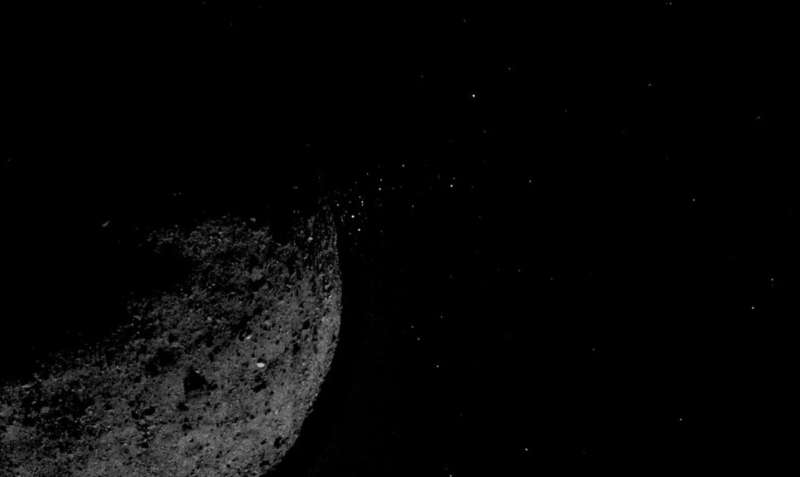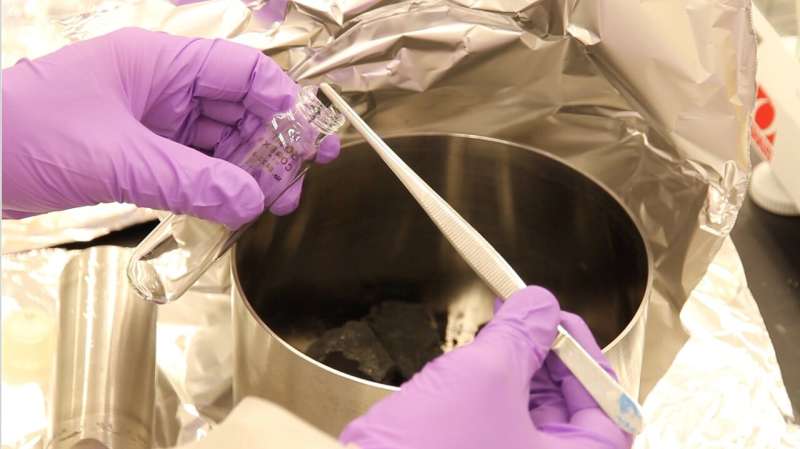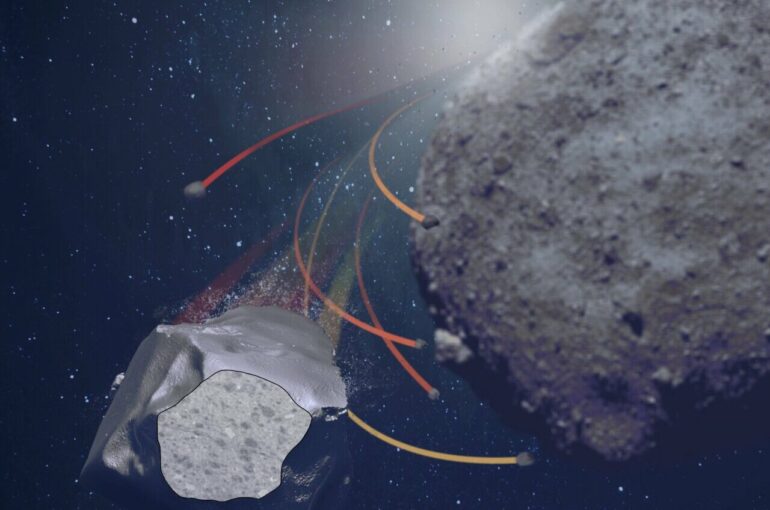In 2019, NASA’s OSIRIS-REx spacecraft sent back images of a geological phenomenon no one had ever seen before: pebbles were flying off the surface of the asteroid Bennu. The asteroid appeared to be shooting off swarms of marble-sized rocks. Scientists had never seen this behavior from an asteroid before, and it’s a mystery exactly why it happens. But in a new paper in Nature Astronomy, researchers show the first evidence of this process in a meteorite.
“It’s fascinating to see something that was just discovered by a space mission on an asteroid millions of miles away from Earth, and find a record from the same geological process in the museum’s meteorite collection,” says Philipp Heck, the Robert A. Pritzker Curator of Meteoritics at Chicago’s Field Museum and the senior author of the Nature Astronomy study.
Meteorites are pieces of rock that fall to Earth from outer space; they can be made of pieces of moons and planets, but most often, they’re broken-off bits of asteroids. The Aguas Zarcas meteorite is named after the Costa Rican town where it fell in 2019; it came to the Field Museum as a donation from Terry and Gail Boudreaux. Heck and his student, Xin Yang, were preparing the meteorite for another study when they noticed something strange.
“We were trying to isolate very tiny minerals from the meteorite by freezing it with liquid nitrogen and thawing it with warm water, to break it up,” says Yang, a graduate student at the Field Museum and the University of Chicago and the paper’s first author. “That works for most meteorites, but this one was kind of weird— we found some compact fragments that wouldn’t break apart.”

Artistic depiction of pebble mixing process from the Aguas Zarcas parent body. Pebble-sized fragments get ejected and redeposited on the asteroid surface. © April I. Neander. Asteroid image: NASA/Goddard/University of Arizona.
Heck says that finding bits of meteorite that won’t disintegrate isn’t unheard of, but scientists usually just shrug and break out the mortar and pestle. “Xin had a very open mind, he said, ‘I’m not going to crush these pebbles to sand, this is interesting,'” says Heck. Instead, the researchers devised a plan to figure out what these pebbles were and why they were so resistant to breaking apart.
“We did CT scans to see how the pebbles compared to the other rocks making up the meteorite,” says Heck. “What was striking is that these components were all squished— normally, they’d be spherical— and they all had the same orientation. They were all deformed in the same direction, by one process.” Something had happened to the pebbles that didn’t happen to the rest of the rock around them.

Pebbles ejected off the surface of asteroid Bennu were observed frequently by NASA’s OSIRIS-REx spacecraft. This observation inspired this study. © NASA/Goddard/University of Arizona/Lockheed Martin.
“This was exciting, we were very curious about what it meant,” says Yang.
The scientists had a clue, though, from the 2019 OSIRIS-REx findings. From there, they put together a hypothesis, which they supported with physical models. The asteroid underwent a high-speed collision, and the area of impact got deformed. That deformed rock eventually broke apart due to the huge temperature differences the asteroid experiences when it rotates, since the side facing the sun is more than 300° F warmer than the side facing away. “This constant thermal cycling makes the rock brittle, and it breaks apart into gravel,” says Heck.
These pebbles are then ejected from the asteroid’s surface. “We don’t yet know what the process is that ejects the pebbles,” says Heck— they might be dislodged by smaller impacts other space collisions, or they might just get released by the thermal stress the asteroid undergoes. But once the pebbles are disturbed, Heck says, “you don’t need much to eject something— the escape velocity is very low.” A recent study of Bennu revealed that its surface is loosely bound and behaves like popcorn in a bucket.

Sampling of the Aguas Zarcas meteorite at the Field Museum of Natural History. © Drew Carhart, Field Museum
The pebbles then entered a very slow orbit around the asteroid, and eventually, they fell back down to its surface further away where there was no deformation. Then, Heck and Yang say, the asteroid underwent another collision, the loose mixed pebbles on the surface got transformed into a solid rock. “It basically packed everything together, and this loose gravel became a cohesive rock,” says Heck. The same impact may have dislodged the new rock, sending it careening into space. Eventually, that chunk fell to Earth as the Aguas Zarcas meteorite, carrying evidence of the pebble mixing.
This could explain the pebbles present in Aguas Zarcas, making the meteorite the first physical evidence of the geological process observed by OSIRIS-REx on Bennu. “It provides a new way of explaining the way that minerals on the surfaces of asteroids get mixed,” says Yang.
That’s a big deal, Heck says, because for a long time, scientists assumed that the main way that the minerals on the surfaces of asteroids get rearranged is through big crashes, which don’t happen very often. “From OSIRIS-REx we know that these particle ejection events are much more frequent than these high-velocity impacts,” says Heck, “so they probably play a more important role in determining the makeup of asteroids and meteorites.”
Aguas Zarcas is the first meteorite to show signs of this behavior, but it’s probably not the only one. “We would expect this in other meteorites,” says Heck. “People just haven’t looked for it yet.”
More information:
Xin Yang, A record of post-accretion asteroid surface mixing preserved in the Aguas Zarcas meteorite, Nature Astronomy (2022). DOI: 10.1038/s41550-022-01746-4. www.nature.com/articles/s41550-022-01746-4
Citation:
Meteorite provides record of asteroids ‘spitting out’ pebbles (2022, August 11)
